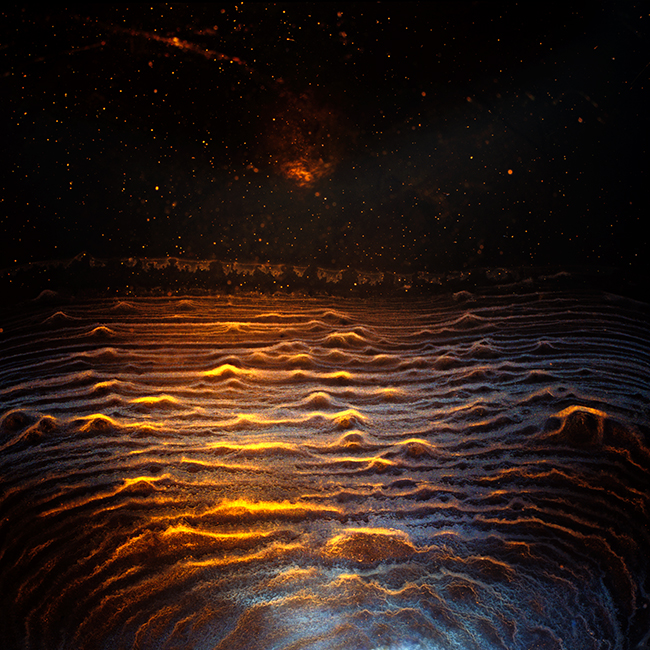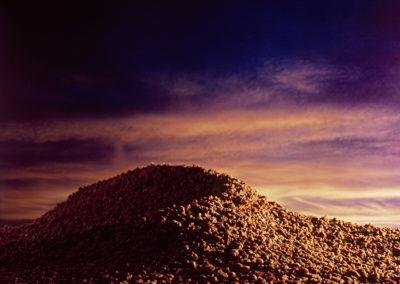Feature Image: Glenlivet 162 © Ernie Button
Ernie Button is an award-winning artist here in Phoenix, Arizona whose photographic work ranges from plastic camera work around the world, to digital tabletop images that reveal new worlds in the bottom of a whisky glass. Ernie has been interested in photography since his early years. He is primarily self-taught after classes at Mesa Community College. For the last 20-plus years, his work has straddled two distinct approaches to image making. Between his photographs made as he travels the world and others that are created in his studio, it’s a photographic version of the nature/nurture paradox.
The travel photographs are done primarily with a Holga (a medium format plastic camera with virtually no exposure controls). Button feels this restricted technology with its soft, vignetted frame edge best implies the sense of memory from his travels. He wrote that the “moments of imperfection in the photograph best mirrors my personal recollections of travel: some elements are sharp in memory, others less distinct.”

John Ford Point, Monument Valley © Ernie Button
The travel photographs are not typical tourist remembrances. Button finds the whimsical and ironic in ordinary places. The series “Monumental China” is his impression of the manufactured landscapes in China. He has visited theme parks in both Beijing and Shenzhen that have recreated scale models of famous European and American architecture and natural wonders. Visitors can wander through replicas of world-famous sites like Ayers rock and Angor Wat before seeing the Parthenon and the Pyramids. Like a Chinese version of Disneyland or Las Vegas, the parks are vacation portals to experience the world without ever having to leave the country. The travel photographs are largely unpeopled adding to the enigmatic scenes.
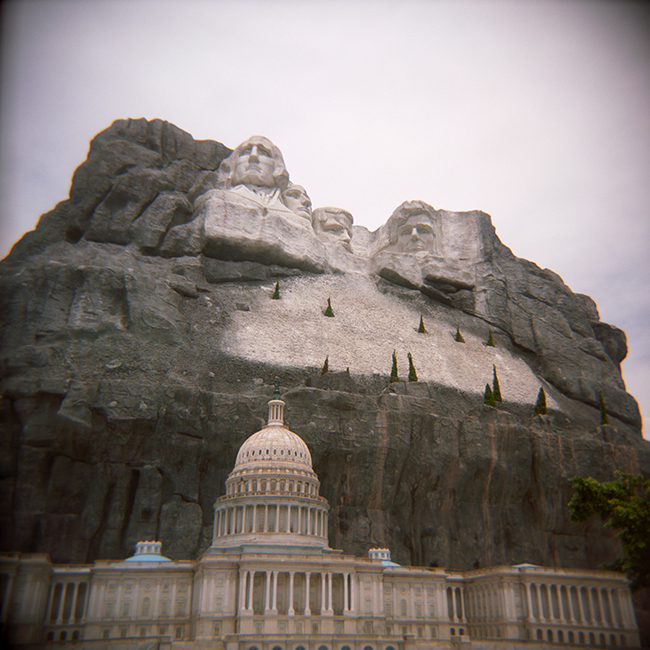
Capital, Mount Rushmore, Shenzhen, China © Ernie Button
When he does photograph people, they often are in miniature form. Done in a studio in extreme close-ups, the series “Playing in the Shadows of Space” or the “Imaginary Combat of Little Green Army Men” features toy figurines in close-up using limited depth of field. The images are at once nostalgic and evocative. The style echoes the work of artists like David Levinthal, though Ernie’s lighting and backgrounds create an ethereal atmosphere in which his characters float in their own boundlessness.
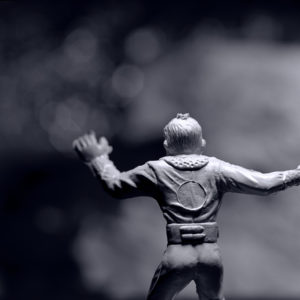 Leaving the Planet Without Me © Ernie Button |
 The Imaginary Combat of Little Green Army Men #11 © Ernie Button |
The series that highlights Button’s inventive sense of humor is “Cerealism.” Otherworldly landscapes are created in the style of a tabletop diorama. Except the “land” and the “creatures” that inhabit the terrain are created from popular supermarket cereals. He adds almost operatic skies from photographs he has made to create these dramatic illustrations.

Great Pyramid of Oatmeal Squares © Ernie Button
Of all the studio work, the most ambitious and ongoing project to date has been the series “Vanishing Spirits, the Dried remains of Single Malt Scotch.” Ernie said the idea came to him when he left used glasses of a single malt scotch out overnight. The thin film of liquid had dried in the glass. As he was about to wash the glasses, he noticed a pattern of fine grey rhythmic lines in the bottom of the glass. When it caught sunlight there was some refracted color reflected. He took the glasses into his studio to experiment with different lights and filters to see if he could coax out the full potential of the dried solids.
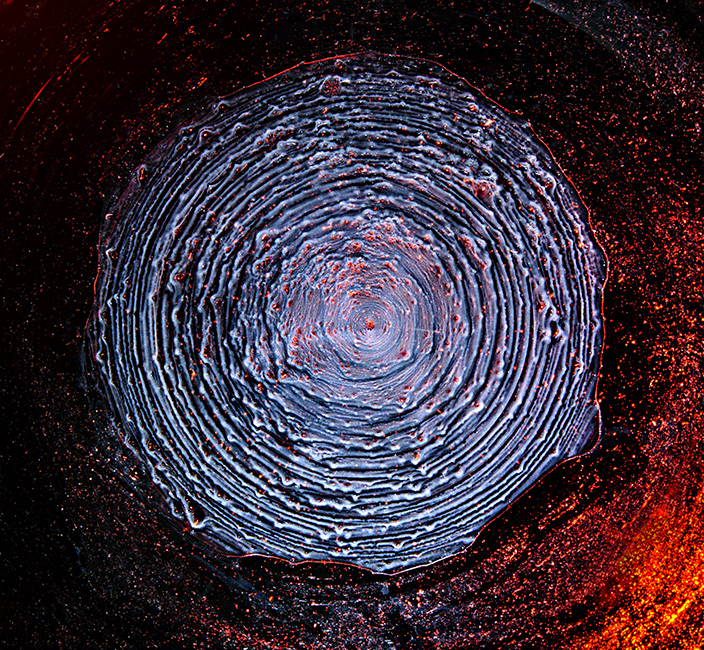
Jura 103 © Ernie Button
This simple observation led to more experimentation and some scientific inquiry into what was occurring in the sediments. Ernie wrote, “The revelation of the mysterious imagery at the bottom of a whisky glass was reminiscent of the magic he felt watching a blank piece of photographic paper gradually reveal itself in a tray of Dektol.” I really wanted to relate the title to Victorian spirit photography but that would be misleading, since that would undermine the scientific effort Button has put into this endeavor.
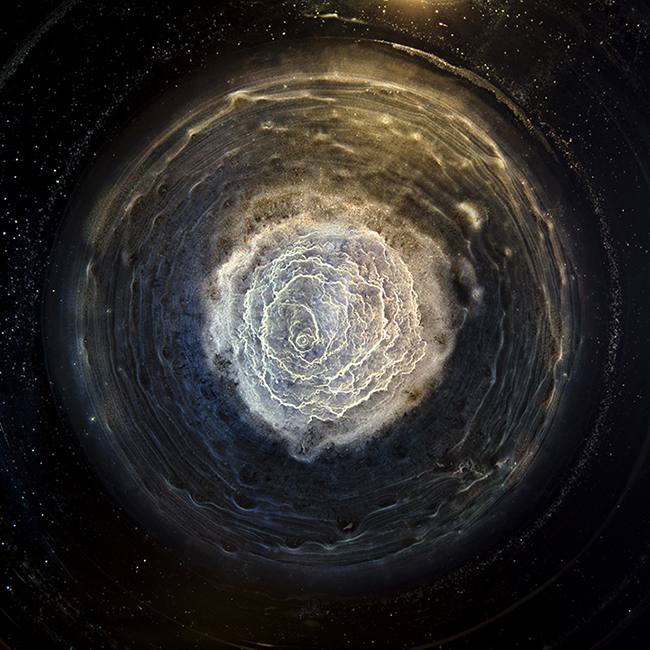
Macallan 150 © Ernie Button
When I first saw the images in the “Vanishing Spirits” series, I immediately associated them with the work from the Hubbell and James Webb space telescopes. But Button said it was about five years before he began to see the illusion of extraterrestrial landscapes that we now associate with the pictures from the telescopes. After he made the connection, he began to sphere the images to emphasize the planetary references.
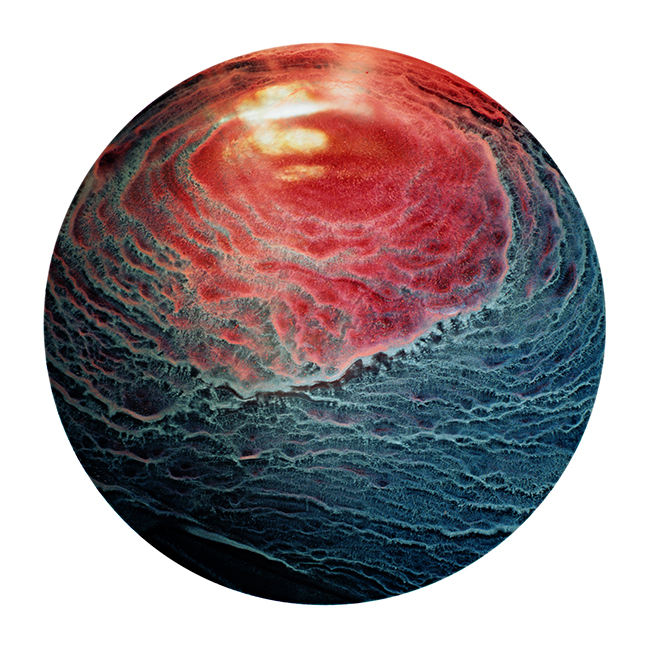
Macallan 101 © Ernie Button
Like the deep space renderings, Button’s initial images are not apparent at first. The final image must be coaxed from the dry grey dregs. He uses lights and colored filters to reveal the full chromatic range. Button found each new whisky seemed to yield a unique design. The patterns are dependent on may factors including humidity, age and alcohol content. It turns out the liquor matters. Ernie’s experiments with clear liquor like vodka or tequila could not reveal the complexity he found in Scotch whiskey.
His research led him to contact both scientists in fluid dynamics and whisky distillers themselves to learn more. Ernie reached out to Dr. Howard Stone, an expert in fluid dynamics and a professor of Mechanical Engineering at Princeton University, to find out why we see the structure of the solids in the leftovers of whisky. In 2010, he contacted some of the leading scotch producers to find out more about the whisky-making process and how wood and time can transform water, barley and yeast into the imagery he was seeing in the dried remains.
He also began sharing those images with the distilleries as well. Macallan, one of the premier whisky distillers in Scotland, invited Button to be part of the Macallan Masters of Photography series in 2014. The distillery has collaborated over the years with artists to create the package and label designs for limited-edition releases for its rarest whiskies. The program has featured well-known artists such as Albert Watson and Annie Leibovitz in prior years. Button’s photographs appeared on several special edition boxings of the Macallan released in Duty Free Shops worldwide. In addition, a portfolio was created by photo-eye Gallery in Santa Fe, New Mexico to highlight the photos made with Macallan whiskies.
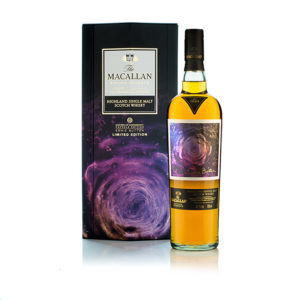 Package and Label Photos for Macallan Estate Reserve © Ernie Button |
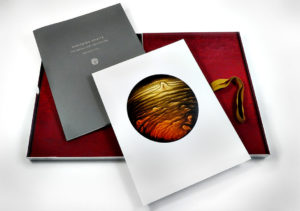 photo-eye Gallery Portfolio |
The series has also been featured in publications such as National Geographic, The New York Times, Popular Photography, and Smithsonian Magazine as well. All these threads came together in 2022 when Button was able to publish The Art of Whisky: The Vanishing Spirits of Single Malt Scotch. The book is divided into chapters representing the major distilling regions in Scotland. Using his Holga, Ernie has accompanied each chapter with photographs made of the locales on his visits to Scotland. The photographs of the dried remains in each chapter corresponds to the distilleries in the regions.

Cover of “The Art of Whisky” by Ernie Button
Charles McLean, a noted whisky expert, wrote an exclusive essay for the book describing the factors that give Scotch whisky its flavor profiles, aromas and complexities. In support of the science behind the images, Dr. Stone wrote a short essay on the experience of experimenting on the fluid dynamics of whisky for the book. (He assigned the research to a pair of post-doctorate students who I imagine were more than willing to assist in the experiment.) Ernie has been working on the “Vanishing Spirits” project for almost as long as it takes to cask an 18-year-old whisky, and he still sees possibilities to explore in the future.
The Art of Whiskey is available through Amazon and the Macallan portfolio is available through photo-eye Gallery in Santa Fe, NM.
Ernie Button Website
Ernie Button Instagram
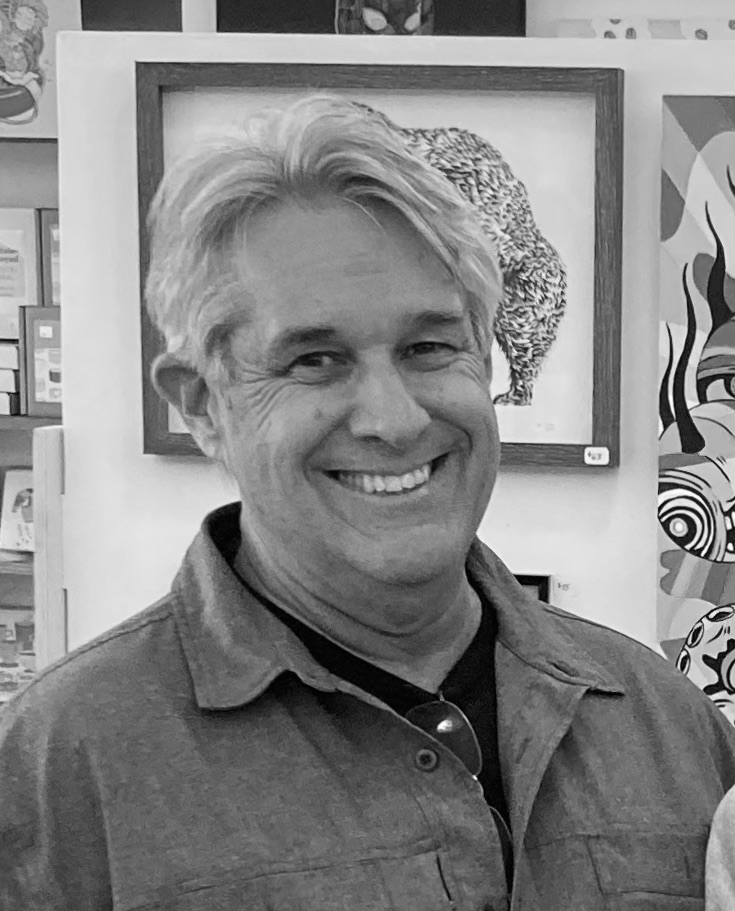
Robert Galloway
Contributing Writer
Bob Galloway began a serious interest in photography after he saw photographs of an early performance art piece and realized the photographs had a more lasting impact than the event itself.
Originally from Ohio, he received a Bachelor of Fine Art in Art from Ohio State University and then moved to the desert in 1979 to pursue a Master of Fine Art in Photography at Arizona State University. Bob is an emeritus professor from Mesa Community College where he taught photography for 39 years.
In addition to teaching, he was an arts administrator for the Maricopa College District for five years, creating the first district wide literature journals, music competitions and art exhibits.
Bob is very encouraged about the embrace of local arts at a grassroots level and hopes to assist in that growth and development. His photographic experience and interests have been wide ranging. Currently he has been looking at how we are using the desert environment as a performance space.
“It’s really difficult to have a bad day when you wake up in the morning and get to talk about art with people.”
Contact Bob

